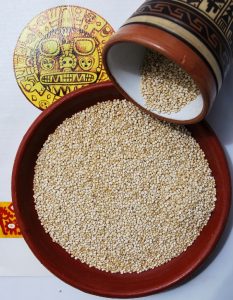International Year of Quinoa Begins

Tiny and multitudinous, quinoa stands as an intriguing symbol of wealth. But its greatest wealth may well be the unusually complete set of proteins as well as minerals and vitamins this seed from the Andes offers. In recognition of its nutritional value and its potential for the United Nations has declared this year, 2013, the International Year of Quinoa.
Although the vast majority of quinoa is grown in Bolivia and Peru, in the high altitudes of the crop’s origin, increasingly it is cultivated in every continent throughout the world and is constantly finding new markets. The seed is living a massive boom as a super-food.
Quinoa is a crop that is only recently starting to undergo the development process of identifying specific varieties of the plant, naming them, assessing their characteristics and then beginning systematic cultivation to improve them. As a result local varieties are being named and marketed relying on the efforts of local officials in places where quinoa is cultivated, such as in the Peruvian regions of Puno and Cuzco, as well as in the Bolivia departments of La Paz and Oruro. These then meet a supply chain that takes the quinoa to market, including exportation to international markets.
The Food and Agricultural Organization (FAO) identifies the following as aims of 2013.
- Increase the visibility of the great potential of quinoa to contribute to global food security, especially in countries where the population has no access to other protein sources or where production conditions are limiting.Prepare technical and policy frameworks for the conservation and sustainable use of quinoa diversity worldwide.Recognize and value the contribution of the indigenous peoples of the Andes as custodians of quinoa who conserve this food for present and future generations.Improve international cooperation and partnerships between public, private and non- governmental organizations related to the cultivation of quinoa.Appreciate the importance of developing sustainable production systems for quinoa for consumption and food security.
As recognition of the importance of this year, quinoa producers in Puno, Peru claim the crop faces difficulties in its land of origin. Despite being stylish in many areas of the world, quinoa has yet to lose its stigma as the food of “Indians” or impoverished rural peoples. As a result, once people move to the city they tend to avoid the food of rural communities and poverty. They argue regional governments and trend setters need to do more to promote local consumption of the seed.

Farmers have also argued that, despite development, the crop suffers from a lack of attention to infrastructure and to the development of solid marketing chains. They would like to see more technology available and more assistance in cultivating and marketing their quinoa.

The International Year of Quinoa tries to turn this relationship with the rural Andes on its head, although in ways that are problematic, through its slogan “A future sown thousands of years ago” as if indigenous people were mired in the past, even if opening a way to the future.
Nevertheless, the day promises to recognize the value of native peoples of the Andes and their ongoing contribution to the world, including the food crops they domesticated, such as quinoa, that have made a contribution to the whole world.
In fact, it was the government of Evo Morales in the Plurinational State of Bolivia that proposed this International Year, as part of its efforts to bring more recognition to indigenous peoples and to decolonize the Americas. Latin American governments, including Peru, jumped on board and the International Year of Quinoa came to fruition when it was proclaimed by the United Nations last year.
As part of this year, the FAO proposes an international congress on quinoa to bring interested parties together, to share information, and to build contacts to enhance the promotion and development of this important crop that, according to the FAO,is the only plant food that contains all the essential amino acids, vitamins, and trace elements and is also gluten free.”
With this year quinoa continues to draw attention and recognition. But best of all, it is wonderful to eat.




